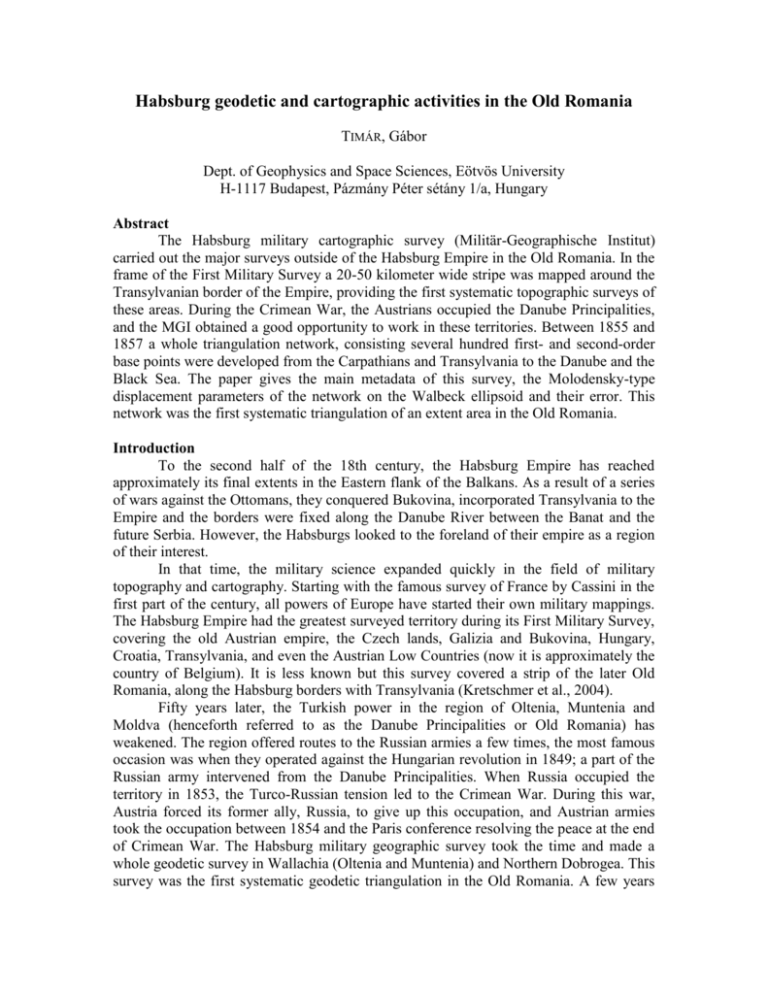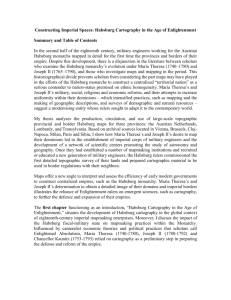Habsburg geodetic and cartographic activities in the Old Romania
advertisement

Habsburg geodetic and cartographic activities in the Old Romania TIMÁR, Gábor Dept. of Geophysics and Space Sciences, Eötvös University H-1117 Budapest, Pázmány Péter sétány 1/a, Hungary Abstract The Habsburg military cartographic survey (Militär-Geographische Institut) carried out the major surveys outside of the Habsburg Empire in the Old Romania. In the frame of the First Military Survey a 20-50 kilometer wide stripe was mapped around the Transylvanian border of the Empire, providing the first systematic topographic surveys of these areas. During the Crimean War, the Austrians occupied the Danube Principalities, and the MGI obtained a good opportunity to work in these territories. Between 1855 and 1857 a whole triangulation network, consisting several hundred first- and second-order base points were developed from the Carpathians and Transylvania to the Danube and the Black Sea. The paper gives the main metadata of this survey, the Molodensky-type displacement parameters of the network on the Walbeck ellipsoid and their error. This network was the first systematic triangulation of an extent area in the Old Romania. Introduction To the second half of the 18th century, the Habsburg Empire has reached approximately its final extents in the Eastern flank of the Balkans. As a result of a series of wars against the Ottomans, they conquered Bukovina, incorporated Transylvania to the Empire and the borders were fixed along the Danube River between the Banat and the future Serbia. However, the Habsburgs looked to the foreland of their empire as a region of their interest. In that time, the military science expanded quickly in the field of military topography and cartography. Starting with the famous survey of France by Cassini in the first part of the century, all powers of Europe have started their own military mappings. The Habsburg Empire had the greatest surveyed territory during its First Military Survey, covering the old Austrian empire, the Czech lands, Galizia and Bukovina, Hungary, Croatia, Transylvania, and even the Austrian Low Countries (now it is approximately the country of Belgium). It is less known but this survey covered a strip of the later Old Romania, along the Habsburg borders with Transylvania (Kretschmer et al., 2004). Fifty years later, the Turkish power in the region of Oltenia, Muntenia and Moldva (henceforth referred to as the Danube Principalities or Old Romania) has weakened. The region offered routes to the Russian armies a few times, the most famous occasion was when they operated against the Hungarian revolution in 1849; a part of the Russian army intervened from the Danube Principalities. When Russia occupied the territory in 1853, the Turco-Russian tension led to the Crimean War. During this war, Austria forced its former ally, Russia, to give up this occupation, and Austrian armies took the occupation between 1854 and the Paris conference resolving the peace at the end of Crimean War. The Habsburg military geographic survey took the time and made a whole geodetic survey in Wallachia (Oltenia and Muntenia) and Northern Dobrogea. This survey was the first systematic geodetic triangulation in the Old Romania. A few years later Col. A. Cuza united the principalities, forming the modern Romania, which gained its full independence from the Turcs and also from the Russians at the conference of Berlin (1878). From this point, Romania worked out its own cartographic basis (Dragomir, 1975; Osachi-Costache, 2000; Mugnier, 2001), using also the results of the Habsburg survey. Meanwhile the Austrians (later the Austro-Hungarian Monarchy) issued the series of the so-called ’degree maps’ (sheets with extents of one degree on both directions) based on their own surveys in the Empire, the Wallachia and their later triangulations in the Turkish Balkans. The present works reviews the mentioned Habsburg activities, their results and further usage in Romanian cartographic activities. Extension of the First Habsburg Military Survey to some parts of the Old Romania (1783-86) The First Military Survey of the Habsburg Empire (after Emperor Joseph it is also called ’Josefinische Landesaufnahme’) was carried out between 1769 and 1786. The resulted survey sheets have a scale of 1:28,800. The sheets can be mosaicked but have no real geodetic basis (Hofstätter, 1989; Timár et al., 2007). The survey sheets, however, have a fixed extent; 9600 * 6400 Viennese fathoms (18207 * 12135 meters). Around the Transylvanian borders of the Habsburg Empire, a 20-50 kilometers wide strip of the Old Romania was systematically surveyed during this campaign, in its own sheet system (zone), an independent one from the other parts of the Empire (Fig. 1). Towns like Piatra Neamt (Fig. 2) or the Southern Carpathians to their edge on the lowland (Fig. 3) are shown with very good accuracy, with respect to the early date of mapping. Although the survey had no real geodetic basis, there is a suitable method for georeferencing the map sheets. We can make a mosaic, containing all of the sheets, and assume that the zone has some real projection, even an unknown one. Thus we can define several ground control points (GCPs) with their image (mosaic) and e.g. Stereo-70 coordinates, then make a quadratic polynomial fitting between the image and the projected coordinates. If the assumption of a real projection were correct, the errors would remain low, as the quadratic formulae connect all real projections with low error. In case of the Old Romanian zone of the First Military Survey, the errors are quite high, compared to the modern maps: from a few hundred meters to three kilometers (in the extremities). The sheets, however, can be fit locally more accurate, using just one GCP for a sheet, and shift the content of it without further rotation to the right position (Timár et al., 2007). The triangulation of Wallachia and Northern Dobrogea (1855-57) As it was told in the Introduction, the Austrian occupation of the Danube Principalities offered a splendid possibility to the Viennese military-geographic institute of the Austrian army to make a triangulation survey in this area. After the occupation (August 1854) the Austrians began the survey in 1855 (MGI, 1859). A first-order triangulation frame network, consisting 131 base points, was constructed, where the main branches were the following: - along the Danube from the Iron Gate to Dobrogea; - along the Olt River; - along the Dimbroviţa River, and 2 - along the Buzau River. The baseline of St. Anna (Sîntana; north of Arad) in the historical Hungary and the former astronomical observatory on top of Dl. Sibiului (northwest of Sibiu in Transylvania) were also connected to the first-order network (Fig. 4), crossing the eastern Banat and the Fagaraş area. The branch following the Danube consists several points in the modern Bulgaria (southern bank of the river). Their origin is unclear; the author has no information about a possible extension of the Austrian occupation to the southern bank. The Ferro prime meridian (Timár, 2007) and the Walbeck ellipsoid (a=6,376,896 m; f=1/302.78) were used for the survey (MGI, 1859). The astronomical base point of Movila David (Φ=44° 32’ 20,53”; Λ=45° 0’ 3” east of Ferro) was selected as fundamental point. The azimuth was set using the Pâuna point, from that the Movila David is in direction of 256° 45’ 59.02” (MGI, 1859). The coordinates of the points are given with a precisity of hundredth seconds (Fig. 5). The frame network was partially supplemented by a set of 337 second-order base points. Some parts of the surveyed area were well covered by them (between the Jiu and Olt Rivers, around Bucureşti between the Ialomiţa and Buzau Rivers, and also along the original frame branches, see Fig. 4). It can be supposed that the end of the Crimean War and the Austrian occupation aborted the construction of the second-order network. Comparing the coordinates of points in this network and using their modern coordinates, we can compute the global displacement parameters between the Walachia network and the WGS84. The modern coordinates of the Dealul Sibiului are known (Timár et al., 2004; Kovács and Bartos-Elekes, 2007), its coordinates in the Habsburg cadastral system is given by Marek (1875) and in the Hermannskogel datum by the MGI (1902). The WGS84 coordinates of the ’Clopotniţa’ (Bell Tower) at the Palace of the Metropolitan in Bucureşti can be read well from the Google Maps. Computing the Molodensky-type description parameters of the first-order network in the Walbeck ellipsoid, taking into account the geoid undulations from EGM96 model (NIMA, 1997) the results are the followings: at point dX (m) dY (m) dZ (m) Dealul Sibiului +1331 +64 +351 Bucureşti, Clopotniţa +1304 +83 +364 average +1317 +73 +357 These two points show good correlation, indicating that the triangulation net was well developed. The mean error of the angles of the used triangles is given as cca. 1,5 arc seconds (MGI, 1857), which value is in the order of the ambiguity derived from the above two points. Between 1855 and 1857, the northern principality, Moldva was also occupied by the Austrian troops. However, till the writing of this paper, the author has not find any sign of a similar Moldovan survey in the Vienna archives. Further usage of the Habsburg geodetic data on Romanian and Austrian maps I’ve also tried to find correlation between the coordinates of this triangulation net and the ones used in the later Romanian Lambert-Cholesky 1:20,000 maps (Bartos- 3 Elekes et al., 2007a; 2007b) but no real and useful results were found. It can be assumed however, that the Habsburg geodetic data was later used in the Romanian Bonne projection maps, which is a good field of further research. The Habsburgs themselves used the coordinates of the Old Romanian survey (and also of their later triangulations in the Turkish Balkans) in the 1:200,000 scale degree maps and the famous 1:75,000 series. Summary The Austrian military geographic survey invested a tremendous work into the geodetic and cartographic works in parts of Old Romania, mainly in two waves. First in the second half of the 18th century in the frame of the First Military Survey, then during the Crimean War in Oltenia, Muntenia and Northern Dobrogea, developing a full firstorder triangulation net from the Transylvanian border to the Danube and the Black Sea. The network was on the Walbeck ellipsoid and its Molodensky-type displacement parameters are: dX=+1317 m; dY=+73 m; dZ=+357 m, the error of these figures is under 20 meters. The low error shows that the network was very precise at the time of the survey. The Austrian work in the Danube Principalities preceded the main part of the Second Military Survey in Transylvania (or connected to it), perhaps giving a good training opportunity also for that measurement. Acknowledgements The author is grateful to the Kriegsarchív of Österreichisches Staatsarchív (ÖStA), Wien, and especially to Dr. Róbert Hermann, the head of the Hungarian delegation at this institute, for the possibility of studying the original survey documentations of the Austrian geodetic works. The sheets of the First Military Survey were digitized in the frame of the joint project of the ÖstA and the Arcanum Database Ltd., Budapest, Hungary. Literature Bartos-Elekes Zs., Rus I., Constantinescu S., Crăciunescu V., Ovejanu I. (2007a): Románia topográfiai térképei Lambert-Cholesky vetületben (1916-1959). Geodézia és Kartográfia [Budapest] vol. 59(6), pp. 39-43. Bartos-Elekes, Zs., Rus, I., Constantinescu, S., Crăciunescu, V., Ovejanu, I. (2007b): Topographic maps of Romania under Lambert-Cholesky projection system (19161959). Studii şi Cercetări, Seria Geologie-Geografie [Complexul Muzeal BistriţaNăsăud] vol. 12, pp. 161-168. Dragomir, V. (1975): Evoluţia cartografiei românesti de-a lungul timpului. Terra [Bucureşti] vol. VII (XXVII), pp. 40-47. Kovács B., Bartos-Elekes Zs. (2007): A második katonai felmérés erdélyi főalappontjának felkeresése GPS segítségével. Geodézia és Kartográfia [Budapest] vol. 59(12), pp. 24-25. Hofstätter, E. (1989): Beiträge zur Geschichte der österreichischen Landesaufnahmen, I. Teil, Bundesamt für Eich- und Vermessungwesen, Wien, 196 p. Kretschmer, I., Dörflinger, J., Wawrik, F. (2004): Österreichische Kartographie. Wiener Schiften zur Geographie und Kartographie – Band 15. Institut für Geographie und Regionalforschung der Universität Wien, Wien, 318 p. 4 Marek J. (1875): Technische Anleitung zur Ausführung der trigonometrischen Operationen des Katasters, Magyar Királyi Állami Nyomda, Budapest, 397 p. MGI, Militär-Geographische Institut (1859): Trigonometrische Vermessungen in der Wallachei, ansgeführt durch Offiziere des k.k. Ingenieur-Geografen Corps, in der Jahren 1855, 1856 und 1857. Manuscripts in the Kriegsarchív of Österreiche Staatsarchív, Wien, Archive IDs: Triangulierung 174 & 176. MGI, Militär-Geographische Institut (1902): Die Ergebnisse der Triangulierungen des K. u. K. Militär-Geographischen Institutes, Band I-II. Druck der KaiserlichKöniglichen Hof- und Staatsdruckerei, Wien, Abschnitt I.: Geodätische Coordinaten, pp. 1-122. Mugnier, C. J. (2001): Grids & datums – România. Photogrammetric Engineering and Remote Sensing vol. 67, pp. 545 & 547-548. NIMA, National Imagery and Mapping Agency, National Aeronautics and Space Administration GSFC (1997): WGS84 EGM96 (complete to degree and order 360) 1st Edition. NIMA-NASA GSFC, St. Louis, Missouri, USA. Osachi-Costache, G. (2000): Principele hărţi ale Muntenei din perioada 1860-1980, cu privire specială, asupra Muscelului Argesului. In: Analea Unversitătii din Bucureşti-Geografie, 2000, pp. 133-141. Timár, G. (2007): A ferrói kezdőmeridián. Geodézia és Kartográfia [Budapest] vol. 59(12), pp. 3-7. Timár G., Molnár G., Păunescu C., Pendea F. (2004): A második és harmadik katonai felmérés erdélyi szelvényeinek vetületi és dátumparaméterei. Geodézia és Kartográfia [Budapest] vol. 56(5), pp 12-16. Timár, G., Biszak, S., Molnár, G., Székely, B., Imecs, Z., Jankó, A. (2007): Digitized maps of the Habsburg Empire – First and Second Military Survey, Grossfürstenthum Siebenbürgen. DVD issue, Arcanum Adatbázis Kiadó, Budapest. ISBN 978-963-73746-0-9 Figure captions: Fig. 1. Overview map of the sheets of the First Military Survey in the Old Romania. Fig. 2. Map detail of Piatra Neamt (First Military Survey of the Habsburg Empire). Fig. 3. Map detail around the Monastery of Kozia (north of Rîmnicu Valcea; First Military Survey of the Habsburg Empire). Fig. 4. The triangulation points of the Habsburg geodetic survey of Wallachia (1855-57). Black points: the first-order frame network; white points: second-order points. Fig. 5. A sheet of the original point list in the Viennese Archive (MGI, 1859). The altitudes are given in Viennese fathoms. Fig. 6. The original text describing the Movila David point and its azimuth (MGI, 1859). 5









